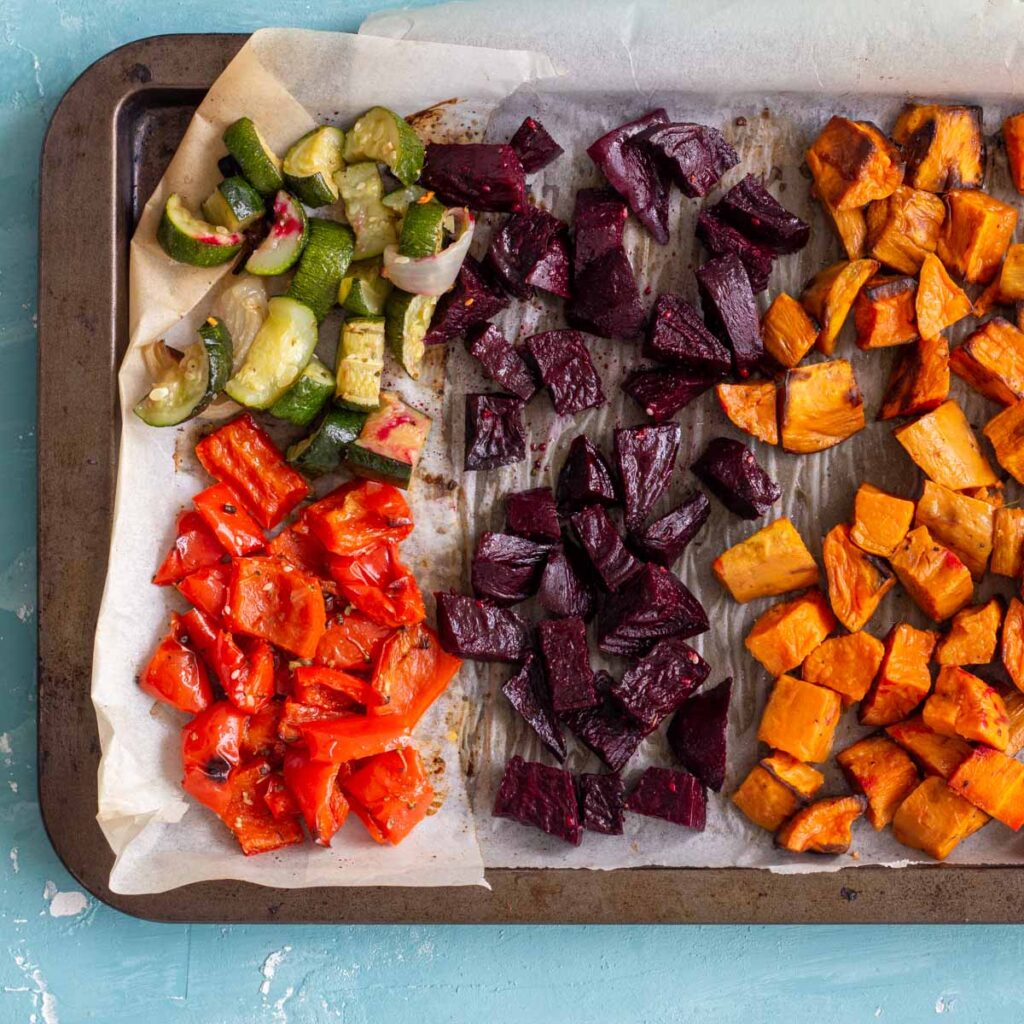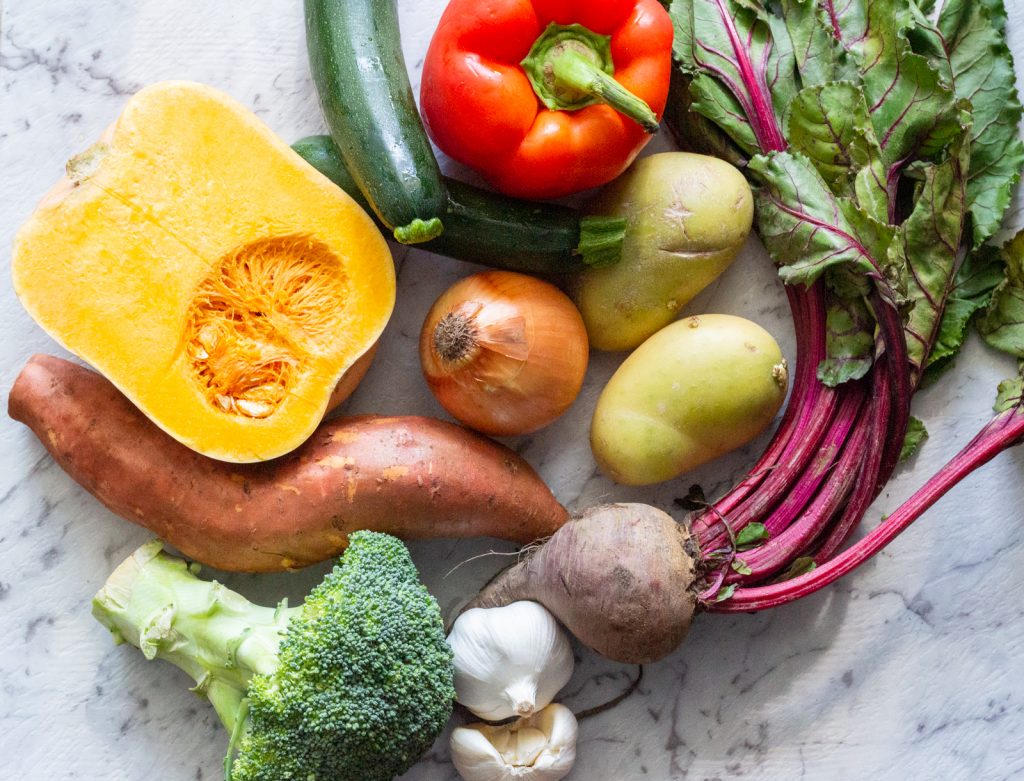A guide to roasting vegetables – things to keep in mind when deciding to roast vegetables, how to roast different types of vegetables, and how to serve and use the super delicious roasted vegetables.

Let me be honest. I have struggled with roasting vegetables many times – it’s not a common technique in a Pakistani or Indian household. Even when we make full chicken (or charga) we cook and fry it, but rarely roast. It’s only in the last few years that I got the hang of roasting vegetables, and once I did, I fell in love with the technique.
There’s so much that can be done with roasted vegetables, and it’s a great way to encourage people to eat more vegetables. Use the recipe card at the bottom as a guide to roasting vegetables depending on what you like, as well as what is available in season. I have given instructions on how to cut different vegetables, along with an approximate roasting time, and lots of seasoning options in the recipe card.
So, here is my guide to roasting vegetables:
What I have learnt is that there are four things to keep in mind when roasting vegetables. They are as follows:
1. Type of vegetable:
Pretty much all vegetables can be roasted, but certain vegetables are more suited to roasting than others. Vegetables can be grouped into categories, which also indicates the time in which they will roast: For instance:
- Root vegetables – this category of vegetable is most popular when it comes to roasting and takes the most time. This includes potatoes, sweet potatoes, squash, pumpkin, carrots, beetroot, etc.
- Cruciferous vegetables – this includes broccoli, cauliflower, brussels sprouts etc.
- Soft vegetables – this includes vegetables such as onions, zucchini, bell peppers / capsicum.
- Thin vegetables – this includes vegetables such as asparagus and green beans.
- Garlic – roasted garlic changes flavour and turns sweet when it caramelises. Garlic cloves can be added when roasting vegetables to add flavour, and a full bulb of garlic can also be roasted to use in recipes.
- Mushrooms and tomatoes – mushrooms and tomatoes tend to release moisture when roasted, so they should ideally be roasted separate from other vegetables. Once roasted, they can then be eaten on their own, or used in different recipes.
2. Temperature:
Vegetables need to be roasted at a high temperature, ideally 200 – 220°C / 400 - 450°F (200°C fan). This is so that they caramelize and get roasted from the outside, while the inside is soft and fork tender. If vegetables are roasted at a lower temperature, the vegetables will steam and overcook instead of being roasted.
3. The way the vegetable is cut:
It’s important to cut the vegetables into uniform pieces – this will make them cook evenly and at the same time. Vegetables that are cut into smaller pieces will cook more quickly, whereas larger pieces will take longer to cook.
4. Time:
Roasting vegetables properly takes time. Root vegetables (such as sweet potatoes and beetroot) take about 40 minutes whereas cruciferous vegetables (such as cauliflower or broccoli) take about 25 – 30 minutes. A full potato (such as for baked potatoes) will take more than an hour, depending on its size.
If roasting multiple vegetables together, group them by their estimated roasting time. For instance potatoes, sweet potatoes and beetroot can be kept together whereas onion and zucchini can be kept on the same tray. The total roasting time can be reduced if vegetables are parboiled and roasted.

How to roast vegetables:
- Prepare the vegetables: Wash, rinse, peel and cut the vegetables. Vegetables like potato, sweet potatoes, and beetroot do not need to be peeled, but can be peeled depending on personal choice.
- Preheat the oven: It’s important to put the vegetables in a pre-heated oven. The temperature needs to be high from the beginning.
- Season the vegetables: It’s super important to coat the vegetables in oil, and also to season them. This can be done in a bowl or on the baking, just make sure to do it properly so the vegetables are completely coated. Options for seasoning are limitless and depends on the recipes in which the vegetables will be used – salt, black pepper, dried herbs, Dukkah, garlic powder, onion, chili powder. Fresh herbs such as thyme and rosemary can also be used. Garlic can also be added – it will roast, and add flavour to the rest of the vegetables.
- Prepare the baking tray: Line the baking tray with parchment, baking paper or foil for easier clean-up. I prefer using a reusable silicon mat. When placing the vegetables on the baking tray, make sure not to over crowd them. Arrange them in a single layer as crowding them will result in them cooking unevenly, with certain vegetable pieces steaming instead of roasting.
How to serve and use roasted vegetables:
Roasted vegetables can be served on their own, or with a main dish such as steak or grilled chicken. Roasted vegetables can also be added into salads, used in wraps, sandwiches or bowls, or made into dips and soups. Here are some recipes in which you can use roasted vegetables:
- Tomato and Garlic Soup - roasted tomato and garlic add such a delicious depth of flavor to this tomato soup.
- Roasted Vegetable Salad - roasted vegetables are tossed with dukkah in this vegetarian salad.
- Chicken and mushroom quiches - use leftover roasted vegetables to make these easy mini quiches
- Avocado Toast - top avocado toast with roasted vegetables
- Butternut squash
📖 Recipe
A guide to roasting vegetables
Ingredients
The vegetables (see note 1 for a guide on other vegetables that can be roasted)
- 2 medium / 250g sweet potatoes or potatoes
- 1 medium beetroot
- 2 medium zucchini
- 1 red capsicum / bell pepper cut into large bite-size pieces
Vegetable Seasonings (see note 2 for a guide on other seasonings that can be used)
- 1 ½ teaspoons salt adjust to taste
- 1 ½ teaspoons black pepper
- 1 ½ tablespoons olive oil
Instructions
- Wash all the vegetables (sweet potatoes, beetroot, zucchini and broccoli), and peel as preferred. The sweet potatoes and beetroot don't need to be peeled, but I prefer doing so.
- Cut the sweet potato and beetroot into 2 cm chunks. Cut the zucchini in half, and cut in 2 cm half rounds. Take out the seeds of the red capsicum / bell pepper and cut into 2 cm chunks. It’s important to cut all similar vegetable the same size so they cook evenly.
- Preheat oven to 400°F / 200°C (180°C fan-forced) and prepare 1-2 large baking sheets (depending on how many vegetables you’re roasting) with parchment paper or a non-stick silicon baking sheet.
- Add vegetables to the baking trays depending on their total cook time. The root vegetables (sweet potato and beetroot) will take take longer (around 30 - 40 minutes) and should be on the same baking tray. The zucchini and red bell pepper / capsicum will take less time, so they can be on the same tray. Cruciferous vegetables like broccoli or cauliflower take less time, and so should be placed on the same tray.
- Drizzle the vegetables with olive oil and season with salt and black pepper. Additional flavourings of choice can be added at this stage. Toss the vegetables to make sure they are coated with the oil, and seasonings. This can be done in a bowl prior to putting them on the baking tray, or on the baking tray itself.
- Roast in the oven till the vegetables are roasted and charred on the edges from the outside and soft from inside. Halfway through the baking process, toss the veggies around. This will ensure that they cook on all sides. Roasting time will differ depending on the vegetables – the zucchini and red bell pepper / capsicum will take about 20 – 25 minutes, whereas the sweet potatoes and beetroot will take about 30 - 40 minutes. To check if the root vegetables are done, just pierce with a fork. If it pierces through they are cooked.
- Eat the roasted vegetables right away or serve them with your favourite protein. Leftovers can be kept in the fridge in an airtight container for around 4 – 5 days. To reheat, place them in a preheated oven at 400°F / 200°C (180°C fan-forceuntil hot or use an air fryer, or you can reheat them on a stovetop.
- Leftover roasted vegetables can also be frozen but their texture will be on the soft side once frozen, so they would best be used in recipes such as soups, smoothies or dips.
Notes
Note 1: Guide to roasting vegetables, along with estimated roasting time:
Pretty much all vegetables can be roasted. Here are some of the popular ones, including how to cut them and roasting time guidelines.Root vegetables (sweet potatoes, beetroot, carrots, potatoes, etc): Rinse the root vegetables well, and peel (this step can be skipped though). Cut into 2 cm chunks, or slice in rounds. They will take about 30 – 40 depending on how small they are cut.
Cruciferous vegetables (broccoli, cauliflower, Brussels sprouts): Cut the stalk of the broccoli and cauliflower and cut the florets into large bite sized pieces. Trim the brussel sprouts and cut them in half. They will take about 15 to 25 minutes.
Soft vegetables (zucchini, bell peppers / capsicums): Cut the zucchini in half, and then cut into 2 cm rounds or cubes. Cut the bell peppers / capsicum in 2 cm cubes as well. They will take about 15 to 20 minutes.
Thin vegetables (asparagus, green beans): Trim the ends of the asparagus and green beans, and then cut them into 1 – 2 inch pieces on the diagonal. Roast for around 10 to 20 minutes
Onions: Remove the skin from the onions, and cut the onions into wedges – there is no need to separate the slices. They will take about 25 – 30 minutes.
Tomatoes: Depends on the type of tomatoes used. Cherry or grape tomatoes are small, so they will take about 15 – 20 minutes until the skins burst. Regular tomatoes (roma tomatoes or Italian plum) can be kept whole, or cut in half depending on how big they are. They will take about 35 – 40 minutes until the skin softens and starts to burst.
Note 2: Vegetable Seasoning Options:
If you are roasting vegetables in bulk for use in multiple recipes later on, it’s best to season them with only salt. That way you can add additional flavourings later on. If you are roasting vegetables for specific recipes, then season as required. Some options include:- Garlic cloves – garlic adds flavor and aroma to the vegetables, and the roasted garlic can also be used in other recipes later on. Garlic cloves and minced garlic are also options.
- Italian herbs – fresh and dried herbs both can be used to flavour roasted vegetables. In the case of fresh herbs, hearty herbs like rosemary and thyme can be added right in the beginning, but herbs like basil should be added in the last 10 minutes or so, as they can wilt and burn.
- Dukkah – this Egyptian spice and nut blend is a new favourite way of mine in roasting vegetables.
- Add spice in the form of black pepper, white pepper or chili flakes. Chilli flakes should be added in the last stage of roasting, as the flakes can also burn.
- Vegetables can also be given a Desi kick by the addition of Pakistani and Indian spices such as roasted cumin seeds (bhuna zeera), tandoori paste, tikka masala, or perhaps even garam masala and chaat masala.
- Other – onion powder, poppy seeds, bag







Sally says
Thank you for sharing such a detailed guide on roasting vegetables.